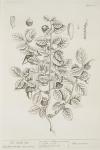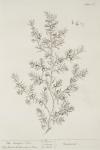

 185. Field Scabious. Scabiosa vulgaris pratensis.
185. Field Scabious. Scabiosa vulgaris pratensis.
1. The Stalks grow to be two or three Foot high, the Leaves are a grass Green, and the Flowers purple.
2. It grows in Meadows, and flowers in Iune.
3. The Leaves are esteem'd cordial alexipharmic, sudorific, pectoral, good for Distempers of the Lungs, as Coughs, shortness of Breath, &c., as also sore Throats and Quinsies. Outwardly, they are serviceable in the Itch, scabby sores, Tettars and other cutaneous Distempers. They also take black and blue Marks out of the Skin.
4. Greek, ψώρα. Latin, Scabiosa. Spanish, . Italian, Scabiosa. French, Scabieuse. German, Apostemen Craut. Dutch, Scabiense.

 186. The Scarlet Oak. Ilex coccigera.
186. The Scarlet Oak. Ilex coccigera.
Also see #186. The Scarlet Oak - 193. The Cork Tree
1. This is a small shrubby Oak, with prickly Leaves, on the Twigs of which grow little round Grains, or rather Nests of Insects of a shining reddish Colour, about as big as Peas, made by small Flies; These Nests are gathered while they are full of little Worms, and being beat in a Mortar, the Scarlet Liquor is strain'd thro a Sieve, and mixt with its equal Weight of Sugar, which is the Succus Kermes of the Shops.
2. It grows in the southern Parts of France, Italy and Turky.
3. The Succus Kermes is accounted cordial, moderatly binding, comforting ye Heart, chearing the Animal Spirits, and good to prevent Miscarrying. It also drives out the small Pox and Measles.
4. Greek, Κοκκος Βαφικη. Latin, Ilex acculeata cocciglandifera. Spanish, Grana in Grano. Italian, Grana da tingere. French, Vermillon. German, Scharlachbeer. Dutch, Scharlaaken Besien Boom.

 187. The Juniper Tree. Juniperus.
187. The Juniper Tree. Juniperus.
Also see #187. The Juniper Tree - #214. The Savine Tree
1. This seldome grows to any great Bigness in England; the Leaves are a bluish Green, the Flowers a greenish Yellow, and the Berries black.
2. It grows upon Heaths, and flowers in May and Iune; the Berries are green the first Year and ripe the Second.
3. The Wood, Berries and Gum are used; the Wood is accounted hot, dry and cephalic, good to burn in times of Pestilence & contagious Distempers. - The Berries are esteemed carminative, diuretic, expelling Wind, and usefull in the Stone, Gravel & Stoppage of Urine. The Fume of the Gum is said to be good for Cattarrhs, & serous Defluxions upon the Nose and Eyes. The Officinal Preparation is, the Distill'd Oil.
4. Greek, Αγκευδισ. Latin, Juniperus vulgaris. Spanish, Enebro. Italian, Ginepro. French, Feneure. German, Bectholter. Dutch, Deneber Boom.

 188. The Ivy Tree. Hedera arborea.
188. The Ivy Tree. Hedera arborea.
1. This Shrub climbs upon any Thing it grows to, the Leaves are a deep Green, ye Flowers yellow, and the Berries black.
2. It grows in Hedges, & flowers in September, ye Berries being ripe in January & February.
3. The Leaves are accounted good for Inflammations in Issues, Scabs, Sores & scald Heads. Mr. Boyle commends a large Dose of the full ripe Berries as a Remedy against ye Plague. The Gum is said to take spots and Freckles out of the Face.
4. Greek, Κασος. Latin, Hedera. Spanish, Eda, or Hedera. Italian, Lella, or Hedera. French, Lierre. German, Rawer. Dutch, Klimop Boombyl.

